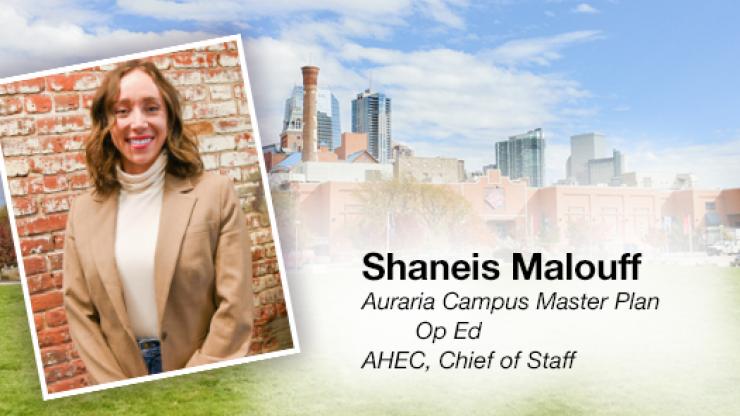
We recommend avoiding the area around Tivoli Quad due to increased activity. For more info, visit AHEC.edu.
Auraria Master Plan Op Ed
The previous Auraria Campus Master Plan was enacted in 2007, a few years before I started as a student here. Today, as Auraria initiates the next master plan for the campus, I'm compelled to share my perspective as both a prior student and now Auraria Higher Education Center's (AHEC) Chief of Staff.
AHEC oversees campus operations and safety. AHEC's staff consists of the Auraria Campus Police Department (ACPD), janitorial crew, grounds and parking technicians, events crew, and sustainability leaders who develop our campus climate action plan. AHEC also manages the Tivoli Student Union, King Center, and Early Learning Center, providing essential services to students, staff, and faculty. Lastly, as Colorado's largest and most diverse higher-ed campus, AHEC's administrative team collaborates with institutions to meet their physical space needs. This is no easy feat.
Success for AHEC means our work is primarily behind the scenes. Most of our interaction with students is through educational institutions. This is intentional because, in our team's eyes, we're having a good day if students haven't needed to call ACPD or our facilities crew with safety or operations concerns. We want students on campus to be able to focus on what’s most important: their studies.
I know the lack of face-time with students can stir rumors about AHEC, rumors around misunderstood financial or organizational structures. To clarify, AHEC is a state entity. This means AHEC adheres to the state classification system for pay, resulting in salaries below market averages. This is true for front-line employees and leadership alike.
We operate lean, and I'm inspired by how hard our teams work to serve our constituents: YOU!
Because Colorado ranks 49th nationally in higher-education funding, our annual state appropriation (the taxpayer funds we receive to operate the campus) falls short by millions annually. We rely on events, parking, and auxiliary services to cover this shortfall.
Auraria needs to maintain a high standard for our physical spaces and remain attractive to current and future students and educators. To do so, we must generate revenue. While this may seem conflicting, I've learned any revenue generated through events, parking, or future development is reinvested into campus. Even if we cover AHEC's fiscal shortfall, many projects will still need funding, starting with the accumulating $80 million in deferred maintenance for our campus facilities.
As a third-generation alumni from this campus, I understand the concern of commercialization. Fortunately, our current campus governance requires future development decisions to be made in partnership with our educational institutions. How? Leaders at all three institutions make up the voting majority of the Auraria Board of Directors (ABOD), the sole entity of future development decision authority. Voting members include our higher educational leaders and governor appointees. Another interesting governance fact I’ve learned is that there is no AHEC voting member on the Auraria Board. Meaning the board’s structure is intentionally higher education focused on both membership and decision-making.
While the Master Plan sets a direction, it doesn't 'set in stone' every future building or development. Prime example, the 2007 Master Plan called for the demolition of the Library. That clearly (and thank goodness) never happened. The vision of the new Master Plan fosters collaboration to create new facilities, programs, and multi-use buildings, shifting from a siloed approach. Our institutions are dynamic, and plans must be flexible to meet current and future needs. Just like the need to keep our beloved Library despite our 2007 plan. Without an updated long-term vision, development can become disjointed and create issues over time. How does this plan emphasize collaboration? Well, this is my favorite part of the Master Plan. Developments must be facilitated by the Integrative Planning Group (IPG), a new group represented by faculty, staff, and students of our campus entities that serve the best interests of the Auraria community. For instance, if an institution proposes building student housing, the IPG will evaluate this need, partnering with institutional potential synergies, and determine the best location together.
While AHEC doesn't have a direct relationship with students, we need your input to envision Auraria's future. How can students participate in the IPG? Through Student Advisory Committee to the Board (SACAB) engagement! Although I wasn't a student when the last plan was enacted, I've witnessed the prior Master Plan's vision come to life since returning, manifesting in the new aerospace facility, student success center, hospitality center, and other enhanced buildings. Not being a member of SACAB is one of my only regrets from my time here.
We know we can improve engagement efforts. Thus, we have postponed the ABOD vote on the new plan to continue gathering input, targeting June. We must find more ways to hear from one another. I urge you to review the plan summary and engagement schedule at www.ahec.edu. To submit questions, please visit here.
In short, Auraria has been a game-changer not only for my family but for so many Coloradans to date. The proof is in the data: The institutions on campus serve as a pipeline for more graduates into the Colorado workforce than any other higher education institution in the state. For example, I attended a top medical program after graduating from MSU Denver. Shortly after that, I returned to practice locally. Fast forward a few more years, I found the voice I learned on campus, leading a civilian-led bill to the Colorado General Assembly to improve statewide equitable healthcare access. My story is akin to so many other changemakers and innovators graduating from this campus. We're a passionate bunch.
We are all committed to this campus community, and YOU can help shape its future.
Contributing Author: Shaneis Malouff


